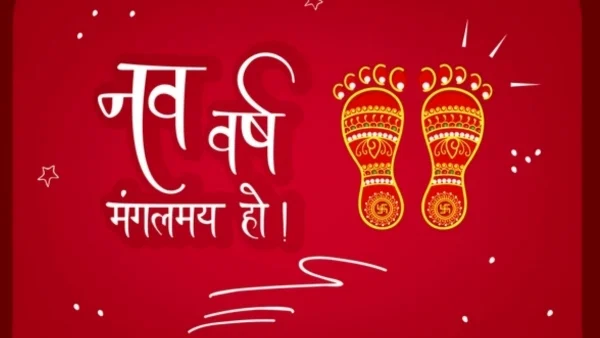Discover the significance of Hindu Nav Varsh (Hindu New Year). Explore the rich traditions, regional variations, and customs that make this festival a time for renewal and celebration.
Hindu Nav Varsh, also known as the Hindu New Year, is a vibrant and significant festival that marks the beginning of a new year according to the Hindu lunisolar calendar. Celebrated with fervor and enthusiasm by millions of Hindus across the globe, this festival is more than just a change in the calendar; it’s a time of renewal, reflection, and tradition. Celebrated primarily in India, Hindu Nav Varsh brings together families and communities to honor their heritage and embrace new beginnings.
The Significance of Hindu Nav Varsh
Hindu Nav Varsh falls on the first day of the Chaitra month of the Hindu calendar, which typically coincides with the Gregorian months of March or April. The festival signifies the start of a new cycle, representing the triumph of good over evil and the promise of prosperity and abundance. It is believed that this day marks the creation of the universe by Lord Brahma, the creator god in Hindu mythology.
For many Hindus, this day holds deep spiritual significance, as it is considered an auspicious time to begin new ventures, buy property, or make important life decisions. The festival is observed with various customs and rituals, each carrying its own symbolic meaning.

Regional Celebrations of Hindu Nav Varsh
While Hindu Nav Varsh is celebrated across India, the way it is observed varies depending on the region. Different states and communities have their unique traditions and practices associated with the festival. Let’s take a look at how this festival is celebrated in different parts of India:
1. Gudi Padwa (Maharashtra and Goa)
In Maharashtra and Goa, the festival is known as Gudi Padwa. On this day, people decorate their homes with rangolis (colorful patterns made from powders) and set up a “Gudi,” a pole adorned with a cloth, neem leaves, and a garland. The Gudi is believed to bring good fortune and symbolizes victory and prosperity. People wear new clothes, prepare special sweets like puran poli and shrikhand, and participate in processions that fill the streets with joy.
2. Ugadi (Andhra Pradesh, Karnataka, Telangana)
In the southern states of Andhra Pradesh, Karnataka, and Telangana, the festival is celebrated as Ugadi. The day begins with a ritual oil bath, followed by prayers to seek blessings for the coming year. A traditional dish called Ugadi Pachadi, made with raw mangoes, tamarind, jaggery, and neem leaves, is prepared to symbolize the diverse flavors of life—sweet, sour, bitter, and spicy.
3. Vaisakhi (Punjab)
In Punjab, the celebration of the Hindu New Year is called Vaisakhi. This festival also holds great significance for Sikhs, as it commemorates the formation of the Khalsa in 1699. Vaisakhi is marked by vibrant processions, prayers, and celebrations that include dancing to the rhythm of the dhol (drum). Farmers also celebrate the harvest and offer thanks for a bountiful crop.
4. Baisakh (West Bengal)
In West Bengal, the first day of the Bengali New Year is called Poila Baisakh. It is a time for family gatherings, shopping for new clothes, and enjoying traditional Bengali dishes. Many businesses open new account books on this day, marking the start of a fresh financial year. The day is filled with cultural performances, including folk music and dance.

Common Customs and Rituals
Despite regional variations, some common rituals and traditions are observed across all celebrations of Hindu Nav Varsh:
- Temple Visits and Pujas: Devotees visit temples to seek blessings from deities like Lord Vishnu, Lord Ganesha, and Goddess Lakshmi. Prayers and pujas are performed to ensure prosperity, health, and success in the coming year.
- Cleaning and Decorating Homes: People clean and redecorate their homes, symbolizing the removal of negativity and the welcoming of new opportunities. Rangolis and torans (decorative door hangings) are placed at the entrance of homes to invite good fortune.
- Feasts and Sweets: The festival is marked by a variety of traditional dishes, including halwa, kheer, and regional specialties like puran poli (Maharashtra) and ugadi pachadi (Andhra Pradesh). New clothes are worn to mark the occasion, and families come together to celebrate with food, music, and dance.
Hindu Nav Varsh: A Time for Renewal
At its core, Hindu Nav Varsh is a celebration of renewal. It’s a time to reflect on the year gone by, let go of past grievances, and embrace the future with optimism and hope. The festival promotes the values of family, unity, and community, urging individuals to come together in celebration and to work towards collective prosperity and peace.
As Hindu Nav Varsh is celebrated across the world, it continues to serve as a reminder of the cyclical nature of life and the constant opportunity for new beginnings. Whether in the form of prayers, family gatherings, or cultural performances, Hindu Nav Varsh remains a cornerstone of Hindu tradition and spirituality.





